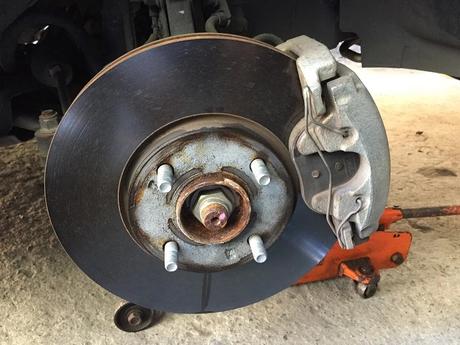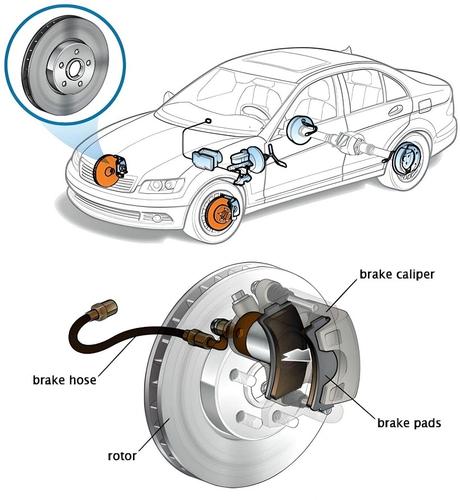
Brakes are one of the most critical components of any vehicle. They ensure your safety on the road, giving you control over stopping your car when needed. But like all mechanical systems, brakes are subject to wear and tear, and one of the common issues drivers face is warped rotors. Understanding the signs of warped rotors can help you identify the problem early, ensuring that you can address it before it leads to more significant issues or even accidents. In this article, we will explore the key signs of warped rotors, helping you stay informed and safe on the road.
👉 What Are Rotors and How Do They Work?
Before diving into the signs of warped rotors, it’s essential to understand what rotors are and their role in the braking system. Rotors, also known as brake discs, are flat, circular metal components connected to your vehicle’s wheels. When you press the brake pedal, brake pads clamp down on the rotors, creating friction that slows down the rotation of the wheels, effectively bringing the car to a stop.

Rotors need to be smooth and even to provide consistent friction when braking. If a rotor becomes warped, it means that its surface is no longer even, which can cause several issues in the braking process.
👉What Causes Warped Rotors?
Warped rotors can occur due to several factors, including:
1. Excessive Heat. When the brakes are applied, the friction generates heat. If the brakes are used aggressively or repeatedly, such as during downhill driving or in stop-and-go traffic, the rotors can overheat. Excessive heat can cause the metal to expand and contract unevenly, leading to warping.
2. Improper Installation. If rotors are not installed correctly or if the wheel lug nuts are tightened unevenly, it can lead to uneven stress on the rotors, causing them to warp over time.
3. Worn Brake Pads. Brake pads that are excessively worn or made of low-quality materials can cause uneven pressure on the rotors, leading to warping.
4. Moisture. When a hot rotor comes into contact with water, it can cool down too quickly, causing it to warp due to thermal shock.
Understanding these causes can help you prevent warped rotors by maintaining your braking system and driving habits. However, even with the best maintenance, rotors can still warp, so recognizing the signs of warped rotors is crucial.
👉 Signs of Warped Rotors
1. Vibrations When BrakingOne of the most common and noticeable signs of warped rotors is a vibration or pulsation when you apply the brakes. This vibration can be felt in the brake pedal, steering wheel, or even throughout the entire vehicle. The reason for this vibration is the uneven surface of the rotor, which causes the brake pads to grip and release in an irregular pattern. This results in a pulsating effect as the car slows down or the car shakes when braking.
The vibration is usually more pronounced at higher speeds and tends to be less noticeable at lower speeds. However, if left unaddressed, the vibration can worsen over time, leading to more severe damage to the braking system and potentially compromising your ability to stop the vehicle safely.
2. Squealing or Squeaking NoisesAnother sign of warped rotors is a high-pitched squealing or squeaking noise when you apply the brakes. While various issues can cause brake noise, including worn brake pads or dirty brake components, warped rotors are a common culprit. The uneven surface of a warped rotor can cause the brake pads to make contact inconsistently, producing a squealing sound.
This noise may start intermittently, but as the rotors become more warped, the noise can become more consistent and louder. If you hear persistent brake noise, it’s essential to have your brakes inspected by a professional to determine the cause and take the necessary steps to address the issue.
3. Brake Pedal Feels Soft or SpongyA soft or spongy brake pedal is another sign that you might have warped rotors. When the rotors are warped, the brake pads do not make even contact with the rotor surface, which can cause the brake pedal to feel less responsive. You may notice that you have to press the brake pedal down further than usual to achieve the same stopping power, or it may feel like the pedal is sinking or has a soft, spongy resistance.
This issue can be hazardous, as it affects your ability to brake efficiently. If you notice a change in how your brake pedal feels, it’s important to have your braking system checked immediately to determine if warped rotors are the cause.
4. Uneven Brake Pad WearWarped rotors can also lead to uneven brake pad wear. Since the surface of the rotor is no longer even, the brake pads will wear down unevenly as they make inconsistent contact with the rotor. You may notice that one brake pad is more worn than the others or that the pads have an uneven wear pattern across their surface.
Uneven brake pad wear not only reduces the effectiveness of your brakes but can also lead to further damage to the rotors and other braking components if not addressed. Regular brake inspections can help you catch uneven wear early, allowing you to replace or resurface the rotors before the problem worsens.
5. Longer Stopping DistancesOne of the most dangerous signs of warped rotors is an increase in stopping distance. When rotors are warped, the brake pads cannot grip the rotor surface as effectively, reducing the overall braking power. As a result, it takes longer for your vehicle to come to a complete stop, especially in emergency situations.
Longer stopping distances are a severe safety concern, as they increase the risk of accidents. If you notice that your car takes longer to stop than usual, it’s crucial to have your brakes inspected immediately to determine if warped rotors are the cause.
6. Visible Rotor DamageIn some cases, you may be able to see visible signs of rotor damage. Warped rotors can develop uneven wear patterns, scoring, or grooves on their surface. If you can safely inspect your rotors through the wheel or by removing the wheel, look for any signs of damage or uneven wear. However, visible damage is often a sign that the warping is severe, and the rotors may need to be replaced rather than resurfaced.
👉 How to Address Warped Rotors
If you suspect that your rotors are warped, it’s essential to take action promptly. Ignoring the signs of warped rotors can lead to more severe damage to your braking system and increase the risk of accidents. Here are the steps you should take:
1. Get a Professional Inspection. The first step is to have a professional mechanic inspect your brakes. They can measure the rotor thickness and check for any warping or other damage.
2. Resurfacing or Replacing the Rotors. Depending on the severity of the warping, your mechanic may recommend resurfacing the rotors to restore a smooth surface. In more severe cases, the rotors may need to be replaced entirely.
3. Check the Entire Braking System. Warped rotors can be a symptom of other underlying issues, such as worn brake pads or improper installation. It’s essential to have the entire braking system checked to ensure that all components are in good working order.
4. Prevent Future Warping. To prevent future rotor warping, practice good driving habits, such as avoiding aggressive braking and ensuring that your brake pads are replaced before they become too worn. Regular brake maintenance, including rotor inspections, can help you catch potential issues early.
💬 Final ThoughtsRecognizing the signs of warped rotors is crucial for maintaining your vehicle's safety and performance. Vibrations when braking, squealing noises, a soft brake pedal, uneven brake pad wear, longer stopping distances, and visible rotor damage are all indicators that your rotors may be warped. If you notice any of these signs, it's essential to have your brakes inspected and repaired promptly. By taking proactive steps to address warped rotors, you can ensure that your vehicle remains safe and reliable on the road.
Want more videos all about auto?
Subscribe to our YouTube channel 👉Cartech Home
